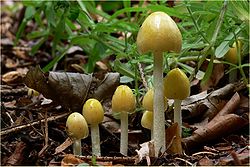| Bolbitius titubans | |
|---|---|
 | |
| Scientific classification | |
| Kingdom: | Fungi |
| Division: | Basidiomycota |
| Class: | Agaricomycetes |
| Order: | Agaricales |
| Family: | Bolbitiaceae |
| Genus: | Bolbitius |
| Species: | B. titubans |
| Binomial name | |
| Bolbitius titubans (Bull.) Fr. | |
| Synonyms | |
| Bolbitius titubans | |
|---|---|
| Mycological characteristics | |
| Gills on hymenium | |
| Cap is ovate or flat | |
| Hymenium is adnate or free | |
| Stipe is bare | |
| Spore print is brown | |
| Ecology is saprotrophic | |
| Edibility is edible, but unpalatable | |
Bolbitius titubans, also known as Bolbitius vitellinus, and commonly known as the sunny side up, [1] [2] is a widespread species of mushroom found in North America. It grows on grass and dung.